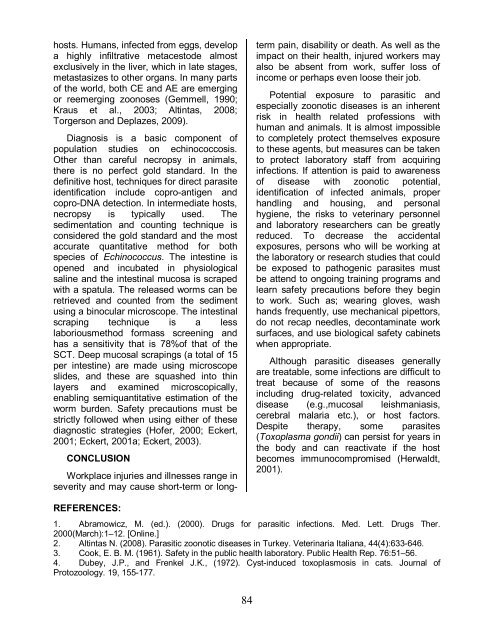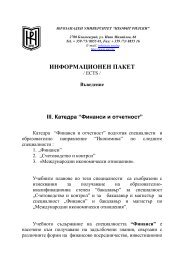ÐÑой 4/2010 - СÑопанÑки ÑакÑлÑÐµÑ - Югозападен ÑнивеÑÑиÑеÑ
ÐÑой 4/2010 - СÑопанÑки ÑакÑлÑÐµÑ - Югозападен ÑнивеÑÑиÑеÑ
ÐÑой 4/2010 - СÑопанÑки ÑакÑлÑÐµÑ - Югозападен ÑнивеÑÑиÑеÑ
You also want an ePaper? Increase the reach of your titles
YUMPU automatically turns print PDFs into web optimized ePapers that Google loves.
hosts. Humans, infected from eggs, develop<br />
a highly infiltrative metacestode almost<br />
exclusively in the liver, which in late stages,<br />
metastasizes to other organs. In many parts<br />
of the world, both CE and AE are emerging<br />
or reemerging zoonoses (Gemmell, 1990;<br />
Kraus et al., 2003; Altintas, 2008;<br />
Torgerson and Deplazes, 2009).<br />
Diagnosis is a basic component of<br />
population studies on echinococcosis.<br />
Other than careful necropsy in animals,<br />
there is no perfect gold standard. In the<br />
definitive host, techniques for direct parasite<br />
identification include copro-antigen and<br />
copro-DNA detection. In intermediate hosts,<br />
necropsy is typically used. The<br />
sedimentation and counting technique is<br />
considered the gold standard and the most<br />
accurate quantitative method for both<br />
species of Echinococcus. The intestine is<br />
opened and incubated in physiological<br />
saline and the intestinal mucosa is scraped<br />
with a spatula. The released worms can be<br />
retrieved and counted from the sediment<br />
using a binocular microscope. The intestinal<br />
scraping technique is a less<br />
laboriousmethod formass screening and<br />
has a sensitivity that is 78%of that of the<br />
SCT. Deep mucosal scrapings (a total of 15<br />
per intestine) are made using microscope<br />
slides, and these are squashed into thin<br />
layers and examined microscopically,<br />
enabling semiquantitative estimation of the<br />
worm burden. Safety precautions must be<br />
strictly followed when using either of these<br />
diagnostic strategies (Hofer, 2000; Eckert,<br />
2001; Eckert, 2001a; Eckert, 2003).<br />
CONCLUSION<br />
Workplace injuries and illnesses range in<br />
severity and may cause short-term or longterm<br />
pain, disability or death. As well as the<br />
impact on their health, injured workers may<br />
also be absent from work, suffer loss of<br />
income or perhaps even loose their job.<br />
Potential exposure to parasitic and<br />
especially zoonotic diseases is an inherent<br />
risk in health related professions with<br />
human and animals. It is almost impossible<br />
to completely protect themselves exposure<br />
to these agents, but measures can be taken<br />
to protect laboratory staff from acquiring<br />
infections. If attention is paid to awareness<br />
of disease with zoonotic potential,<br />
identification of infected animals, proper<br />
handling and housing, and personal<br />
hygiene, the risks to veterinary personnel<br />
and laboratory researchers can be greatly<br />
reduced. To decrease the accidental<br />
exposures, persons who will be working at<br />
the laboratory or research studies that could<br />
be exposed to pathogenic parasites must<br />
be attend to ongoing training programs and<br />
learn safety precautions before they begin<br />
to work. Such as; wearing gloves, wash<br />
hands frequently, use mechanical pipettors,<br />
do not recap needles, decontaminate work<br />
surfaces, and use biological safety cabinets<br />
when appropriate.<br />
Although parasitic diseases generally<br />
are treatable, some infections are difficult to<br />
treat because of some of the reasons<br />
including drug-related toxicity, advanced<br />
disease (e.g.,mucosal leishmaniasis,<br />
cerebral malaria etc.), or host factors.<br />
Despite therapy, some parasites<br />
(Toxoplasma gondii) can persist for years in<br />
the body and can reactivate if the host<br />
becomes immunocompromised (Herwaldt,<br />
2001).<br />
REFERENCES:<br />
1. Abramowicz, M. (ed.). (2000). Drugs for parasitic infections. Med. Lett. Drugs Ther.<br />
2000(March):1–12. [Online.]<br />
2. Altintas N. (2008). Parasitic zoonotic diseases in Turkey. Veterinaria Italiana, 44(4):633-646.<br />
3. Cook, E. B. M. (1961). Safety in the public health laboratory. Public Health Rep. 76:51–56.<br />
4. Dubey, J.P., and Frenkel J.K., (1972). Cyst-induced toxoplasmosis in cats. Journal of<br />
Protozoology. 19, 155-177.<br />
84
















